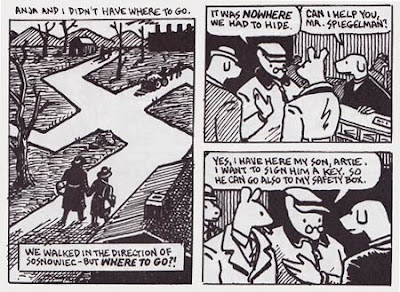I took interest in reading this comic book by Art Spiegelman because it was mentioned during a lecture titled 'Designers as Social Critics'. The book focuses on a Jewish holocaust survivor's personal recount of is life during Nazi Germany, who is also Spiegelman's father: Vladek Spiegelman. It also exemplifies a good use of visual symbols in sequential storytelling. The most prominent one is anthropomorphism to distinguish cultural origins of each of the characters. For instance, the mouses are Jews, the pigs as other Germans and Poles, while the cats are the Nazis, while dogs are the Americans. Each of the characters have the face of an animal, but the body of a human to differentiate them from the real animals in the story.
In the picture below, Spiegelman combines narrative and sequential imagery to let the readers sympathise with his 'failure'. The narratives seems to be a bombardment of facts disconnected from one panel to another, but if it is read while paying attention to the illustrations, they will forge a meaningful statement. For instance, in the illustration on the first panel Spiegelman is wearing a mouse mask signifies that he is trying to identify with his father as he wrote the book, but he can't fully understand his father's feeling because he is not a holocaust survivor. On the second panel, the image zooms out revealing his human hand as a statement diminishing himself to Vladek's heroic status as a holocaust survivor. The last panel explains why the flies are swarming around Spiegelman, which expresses his shame of not being able to represent the his predecessors and Jews who died during the holocaust thus explaining his depression.
On the surface, the comic only seems to be the story of a holocaust survivor. However, upon scrutinisation of codes in the imagery and associations with the texts, society started to realise that MAUS is a profound work of art that reflects cultural and social experience of Spiegelman in response to a world event, which is the holocaust.


No comments:
Post a Comment